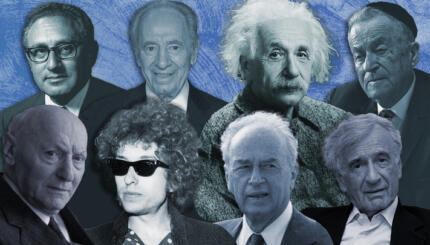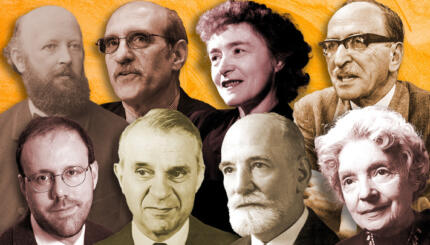Keeping The Faith, a 2000 rabbi-priest buddy picture, boasts the stellar cast of Edward Norton, Ben Stiller, and Jenna Elfman, and Norton’s directorial debut. Writer Stuart Blumberg respects his clergy most when they are involved in a love triangle after a girl they both admired most in the eighth grade returns as a beautiful, high-powered corporate executive.
In an interview with Charlie Rose, Norton described the film as a takeoff on the screwball comedies of the 1930s and ’40s, such as The Philadelphia Story, but actually Blumberg’s script is a fin-de-siecle nod at The Jazz Singer, moving from the cantor to the rabbi, but with the same premise: Love conquers all. If one wants to follow the heart, one cannot be bound by the attitudes and faith of one’s fathers or mothers.
But another angle is added here: If one’s love is deep enough, then one’s faith will be reaffirmed.
Biblical Concerns
I couldn’t help thinking of the well-known passage in the Shema (a major morning and evening prayer), that the heart leads people to stray from the commandments (Numbers 15:39) and of Jeremjah’5 knowing caveat that “the heart is deceitful above all things” (Jeremiah 17:9). Keeping The Faith is not commentary on these themes as much as confirmation of the old biblical concerns. It is symptomatic rather than insightful.

Help us keep Jewish knowledge accessible to millions of people around the world.
Your donation to My Jewish Learning fuels endless journeys of Jewish discovery. With your help, My Jewish Learning can continue to provide nonstop opportunities for learning, connection and growth.
The screenplay is crafty enough. The film, while not a work of fine artifice, has a certain effectiveness. While sitcomish in the writing, it offers a bit more finesse than the usual TV fare in the cutaway shots and editing (though at least one such transition uses Hebrew lettering for the Divine Name to accent some toilet humor).
The craftiness here consists in the impression that the film is advancing New Age “enlightenment.” Visually, the suggestion is that the synagogue is at its best when the sanctuary is emptied of chairs and when Jews gather to practice their own version of Eastern meditation.
But the real message is far more orthodox in the annals of American film: True heaven is romance.
In order to understand what this film represents, we need to take a look at what it actually says about religion. Whether consciously or subconsciously, Blumberg respects the priest more than the rabbi. Norton reported in the same interview that Blumberg wrote the screenplay with him and Stiller in mind. One hopes that the respective depictions of clergy were based on the quirks of the proposed actors, but the consistent, unrelenting undertones of the screenplay suggest deeper ambivalences.
An Unappealing Rabbi
Rabbi Jacob Schram is vain, selfish, and compulsively self-advancing. Since his youth, he has collected rabbi-hero cards (an Orthodox version of baseball cards), not so much out of respect for their teachings as to succeed at acquiring every possible card and thus to beat the “competition,” namely, the other, rather limited group of collectors. The suggestion is made that this same aggressive spirit leads the rabbi to seduce his old school friend who has blossomed into a beautiful woman, in violation of his friendship with the priest.
Blumberg depicts a rabbi who wants sex and companionship with a Gentile woman but is unwilling to give up his congregation. Schram is able to make the synagogue grow, but the implication at every turn is that the crowd is attracted and misled by superficiality and emptiness. The New Age innovations are praised here but come across as hollow, as does the relationship between the rabbi and his girlfriend.
The film keeps insisting, even protesting, that Schram is doing a lot of good things, but it says nothing good about him and about his constituency. The synagogue members are either throwing their daughters at the rabbi or involved in trendy spirituality or in self-promotion. The senior rabbi, played by Eli Wallach, is a seasoned lackey with no real advice to offer.
The only touching and meaningful relationship in the film is that between Norton as the priest and Milos Forman as the older and wiser priest. The only virtue in the film is attributed to Norton’s Father Brian Finn. True, at one point, he is ready to throw away his vows for his childhood friend. But he goes to the woman’s apartment only after she begs him to come, unlike the rabbi who heads there in hot pursuit.
The priest remains loyal to his faith much longer. True, the film opens with the priest in a fall-down drunk state, but it offers disclaimers along the way that he is usually not a drinker, but has been driven to it by his “friends.” No disclaimers are made in behalf ofthe rabbi, except his mother’s statement that he is a “good person.”
Blumberg has his characters observe that it is easier for the woman to seduce the rabbi than the priest because there are no “vows” involved. The suggestion throughout the movie is that Jews have no code, no authority, no discipline, that their only way of exercising religious community is to learn how to manipulate one another as pleasantly and efficiently as possible.
Trite Jokes
In another movie that would be an interesting critique of American Judaism. This movie seems to expect that we adore the rabbi and his innovations lamrot hakol, “in spite of everything,” as the Hebrew saying goes. That is especially disappointing in view of the fact that this is the first and only film in memory to speak of a rabbinic calling, if only for a moment. The movie quickly gets bogged down in requisite circumcision jokes (and now incense jokes for Catholics). Had it even asked the question whether a rabbi can betray a calling, or whether a rabbi has the same calling as other Jews, it might have achieved a certain depth.
The real religion advocated by this film is, I repeat, the Hollywood glorification of romantic love. As rabbi is told by priest (who comes around to the romance-religion, of course): “Do you think God is going to drop a gift like that in your lap a second time?” Voyeurism and phone sex are as effective rituals of this religion of love as are those of synagogue and church.
As I mentioned above, not even the New Age methods preached here–meditation, breathing, etc., which are depicted as worthy innovations, especially in the synagogue–are given reverence and homage in the film. Though we think we are being given a Deepak Chopra-type spiritual adviser in the form of a bartender, we end up with a living infomercial for interfaith marriage–a Sikh-Catholic-Muslim with Jewish in-laws!
Anne Bancroft as the rabbi’s Jewish mother is trotted out solely to offer a mea culpa for all Jewish parents who ever opposed the intermarriage of their children in the name of tribal, as opposed to romantic, religion. It would seem that Love Conquers All has lived to mock both monotheism and New Age trends in the new millennium.
A New “Faith”
Even the term “faith” takes on new meanings here. It is not faithfulness, as in the Hebrew Bible, to a Covenant through loyalty to God, Torah, and the Jewish People. Nor is it the risk taken for Divine grace in the theology of Paul of Tarsus. It isn’t even the faith in one’s own potential of the New Agers. Rather, as Elfman’s Annie puts it, the rabbi must have faith that “other people will understand.”
It is a faith that other people will accept the “ethic” of indulging in selective peccancies: “Give all the people in your life credit to deal with this. It’s the 21st century!” Sin now, confess later, and put your faith in the public’s capacity to forgive.
So Rabbi Schram confesses on eve: “I’m not sorry for loving a Gentile woman, but I’m sorry I didn’t put more faith in you to let me do what I want.” Of course, he gets the job as senior rabbi, and he gets the woman, and the writer even throws in the strong probability that she will convert. The film thereby purports to take up the cause of conversion, as well. Annie tells Jake: “Your faith is a huge part of what I love about you.” She chides him for not being tolerant of others to whom faith comes less easily, but this is cynical because he is not cited for his faith in God but chided for his lack of faith in his public’s adoration.
What could have been a nice insight into agnostics who struggle to convert to Judaism becomes, in reality, the canonization of romantic comedy to sanction and define faith, conversion, and confession. One wonders whether the New York “magasynagogue” that lent its beautiful sanctuary to the filmmaker is pleased with the message and with the use of that distinguished and historic pulpit as an arena for what has become a stock scene, first on the small screen (with David E. Kelley) and then on the big: the “punching out” of rabbis by Jews or Gentiles.
In addition to the film’s text of romantic religion, there is a subtext here that should not go unmentioned. This is another in a long line of films about the “Shiksa Goddess” (played in the 1960s by Cybill Shepherd and Lee Remick) who are superior to Jewish women at everything, including controlling Jewish men and their mothers. [“Shiksa” is a derogatory Yiddish term for a non-Jewish woman.] That quasi-racist subplot is insulting to Jewish women, Gentile women, converts to Judaism, and–especially in this film–to Jewish men, particularly male rabbis.
Reprinted with permission from Over the Top Judaism: Precedents and Trends in the Depiction of Jewish Beliefs and Observances in Film and Television (University Press of America).


